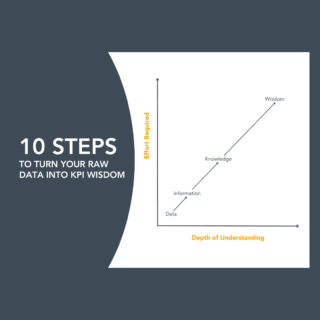If developing KPIs was like writing a self-help book, then positive thinking might reign supreme. But, when it comes to performance measurement, is it the same story or a different one?
Let’s remember that the purpose of measuring within your organization is to drive performance improvement, and to do this effectively we must regularly weigh the pros and cons. There is a reason why a SWOT Analysis equally examines external opportunities and threats as well as internal strengths and weaknesses. We need to have conversations about where our biggest risks lie as well as our strongest opportunities. The same can be said of what we measure.
Skewing too heavily to the “positive” can put our organizations into significant blind spots where we could miss trends that increase our risk of bad things getting worse without us knowing soon enough. Leaders who are true “strategic thinkers” have a willingness to include “what is not working? What is not in balance? What is essential for us to know?” in improvement conversations.
Author and Hungarian-Canadian Physician Gabor Maté recommends exploring the power of negative thinking (slightly tongue in cheek). He says that as soon as we qualify the word “thinking” with the adjective “positive”, we exclude those parts of reality that strike us as ‘negative.’ He says that true positive thinking begins by including all our reality. Our thinking must be guided by the confidence that we can trust ourselves to face the full truth whatever the full truth may turn out to be.
So, let’s consider: When does it matter if we measure the positive vs. the negative? Or does it ever matter?
Just like most things in life, it really does depend on the situation. It depends on the risks involved in choosing whether you measure what we want more of (the positive) or what we want less of (the negative) in the context of what you are trying to achieve.
Where possible, it’s helpful to write results as what we want more of, but sometimes it just doesn’t make sense to measure the positive.
Let’s take workplace safety and consider if it creates more risk (and a leadership blind spot) if we choose to measure positive results vs negative ones.
If we measure the percentage of workers that go home unharmed each day (measuring positively) it is usually a very high percentage of the total workforce. When leaders look at data visualized with this “positive” approach, it will be much harder to detect important changes over time. A 2% increase in the average % of workers going home safely, may not spark much attention when we are at 90%. However, if the actual workplace injuries are tracked instead, leaders will find it much easier to see trends in reductions in injuries over time.
Measuring negatively doesn’t mean the message isn’t positive!
Leaders should focus less on whether the measure is negative or positive, and more on whether the change they want to achieve by using that measure is positive or negative. Being able to prove there are less injuries occurring in the workplace over time is very positive! And measuring the actual injury rate (instead of those not injured) allows leaders to be much more focused and accurate in achieving the outcome the whole workforce wants (less injuries).
The same can be said for these kinds of results that people perceive to be “negative”:
- Patients’ treatments are never delayed
- Our organization sends less to landfill
- People don’t spread the COVID-19 virus
For many people, the desire to write and re-write our performance results or outcome statements as positive can be a hard habit to break.
Watch for these arguments from people who may resist measuring what we want less of when it makes the most sense to do so.
Argument #1: Focusing on the negative drains our energy
- Here’s an example: if we focus on measuring what goes to landfill, it keeps our attention on what we don’t want and makes us feel worse.
- Comeback: Let’s focus on shrinking the gap between the amount of garbage we currently send to landfill and zero. Then our energy can go into finding solutions that continue to shrink the gap. Imagine how awesome it will feel when we get close to sending almost zero garbage to landfill.
Argument #2: It’s depressing to discuss bad news and it feels better to talk about what is happening with positive outcomes.
- Here’s an example: It is depressing when we talk about how our escalators in our facilities are always down. Instead, let’s measure when the escalator system is always working. We will all feel better discussing this.
- Comeback: It is not the job of performance measures to manage our moods! KPIs need to tell us when we need to take action to reduce risk in our organizations. Measuring “% escalator system uptime within tolerance” (what we think we want more of) will actually increase the likelihood that leaders will fail to see the small, but significant lead indicator of a trending increase in “escalator system downtime” and thus make a bad situation worse. Do we want our leaders’ risk to go up exponentially?
Argument #3: Dashboards should always show “up” as good.
- Here’s an example: When building a dashboard for a Call Centre, the dashboard designers decided that all the measures should be framed so that upward movement is “good”. They thought this would make it easier to interpret and allow the leaders to move through the content more quickly.
- Comeback: Monitoring measures should not be a “check box” activity that is done as quickly as possible. The power of measurement is the insight it provides from statistically sound data and visualizations. When measures are related like these three Call Centre measures (Average Call Time, % First Call Resolution, and Average Caller Satisfaction) and the dashboard is built so the direction of the measure is true to its actual performance, then leaders will be able to see if the actions taken by the Call Centre teams when handling calls and resolving issues, had an impact (or not) on customer satisfaction levels.
Measures are like lyrics in a song, and each plays a vital part in the whole story. Appreciate the interactions among measures, and interpret them only in the full context of their relationships. Now this is where we get powerful insights that prove impact!
So, when does it matter if we measure the positive vs the negative?
It matters when…
- The team chooses the measure purposefully because it provides strong evidence that a change is occurring
- The signals of change are accurate
- The measure is sensitive enough to trigger the team to take action when action is needed
These measure traits are much more important than whether it is measuring something positively or negatively.
Never treat measurement as trivial. Instead, invest in the knowledge, capabilities, and techniques your organization needs to accurately and consistently know the truth about what performance is doing, so you can do something about it.



